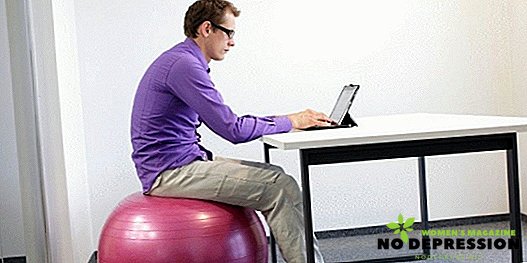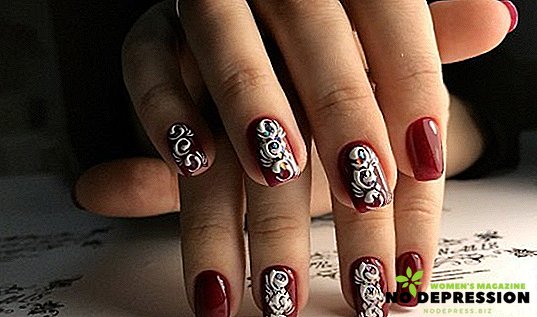Many people want to make a pool in the country, but they believe that its installation will be expensive. However, this is not quite true: you can find inexpensive options on sale, and you can install them yourself.
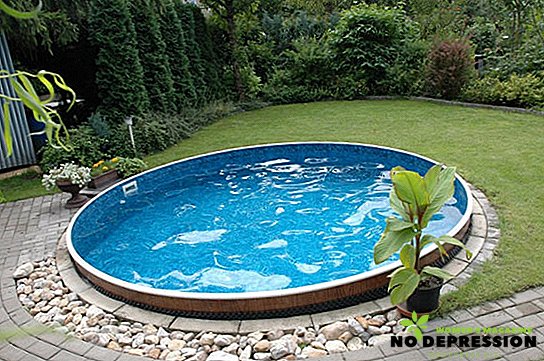
Some tips for choosing
Modern manufacturers offer a huge selection of pools for installation in the country: from economy version to expensive large-scale structures. Before you make a choice, you need to examine factors such as:
- size of the plot and pool;
- the expediency of using the structure in the country;
- service life - year-round or seasonal;
- mobility;
- possibility of transformation.
Such designs can be diverse, inflatable and stationary. Each option has both positive and negative sides. The difference in technical characteristics, size, shape.
Types of pools to give
Before choosing a pool, it is advisable to examine all the advantages and disadvantages of the structures in order to choose the most optimal one for yourself.
Inflatable structures
The advantages of this type of pool include:
- compactness and mobility;
- possibility of installation when the need arises;
- availability at cost - thanks to reasonable prices, any summer resident can afford such a product;
- constructions of this type do not need to be serviced regularly - just rinse it slightly before and after blow-off.
But there are downsides to the following:
- low level of reliability, since such a pool is much easier to damage - a small hole is enough for it to become unusable;
- unattractive appearance;
- dependence on air - the structure is inflated before use, using a pump (if the tool breaks, the pool will lose functionality for a while).
This option is perfect for a small-sized dacha, because it can be easily transferred, after blowing it will not take place on the site.
Due to the fact that the structure is installed on the ground, it is not necessary to carry out any land works for its installation. However, low reliability makes it not the best option.
Also on sale you can find children's inflatable pools. The price of such a product ranges from 600 to 5000 rubles.

Frame option
The frame pool is also mounted on the ground, and not deep into it (no need to dig a pit). It is a container that is most often produced from PVC - this material has more advantages because it is environmentally friendly. Outside design can be either plastic or metal.
Design advantages:
- medium level of reliability - small damage will not make the entire pool unusable;
- ease of use - it just needs to be filled with water;
- attractive appearance due to the variety of colors.
The disadvantages include the need for regular care, constant renewal of water (or it will "bloom"). In addition, the pool should be covered so that leaves and dirt do not fall into the water. Another drawback is the large enough size, which leads to difficulties with transportation if necessary. Also, when dismantling the product, you need to be very careful not to damage the structure.
The price is average: higher than that of an inflatable pool, but lower than that of a deep pool. It is better to choose to install on sites of medium or large size, on small lawns will take up too much space. The cost ranges from 6,000 to 20,000 rubles.

Deep pool
This pool is a structure on the site, installed in a concrete pit. On sale you can find ready-made bowls of various sizes. Lining is applied to the concrete to give the pool an attractive appearance.
The advantages include:
- The monumentality of the design, since it will be very difficult to damage the pool, because the base is located underground, and the outer walls are further strengthened.
- Medium size. With the same size, the deep pool will take less space, because it is located underground.
- Attractive appearance. Through the use of cladding, you can give the pool any look.
- Additional functionality. In such designs there may be additional functions, such as lights, water circulation, hydromassage.

The main disadvantages:
- The need for constant maintenance.
- Enough high cost.
- Difficulties with installation and disassembly.
To save money, you need to purchase a ready-made bowl and install it yourself - without the involvement of specialists and equipment, although this will take more time. The average price per cup is 15,000 rubles.
Self-installation of frame pool
Regardless of the pool option (inflatable or frame), you must first prepare the site. Such types of construction can be prikopat a little in the ground, and put on a prepared land. The main thing is that the surface is smooth. It is undesirable to install the structure on the grass.
Preparation is carried out according to the following scheme:
- Remove the fertile layer at 40-50 cm.
- Making the pit. It all depends on whether it is ruined or installed on the surface. In the first case, the depth should be at least 80 cm, in the second - 20 cm.
- We fall asleep on the bottom of the sand and tamp down - the layer of sand should be about 10 cm. We level, pour water.
- Top lay a layer of textiles, due to which the bottom "does not float." Also, this material will not allow the grass to germinate, will serve as protection against small insects and rodents.
On the prepared base you can already put the pool. The structure has a metal support column and a frame wall, and part of the wall buried in the ground should be warmed. Warm up the bottom too: in this case, the water will heat up faster and cool more slowly.
The guide is as follows:
- Make the bottom of the pit. We take out a metal side, lower it to the bottom and attach it to the profile with the lower edge.
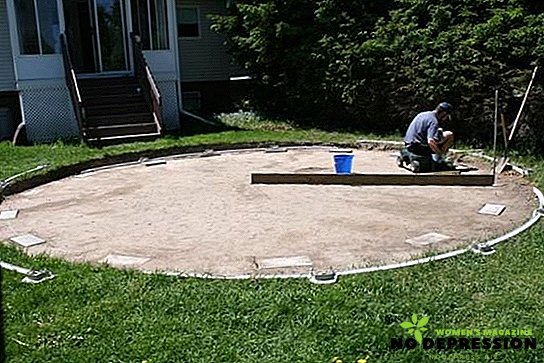
- We take expanded polystyrene, laid out at the bottom. It is very important that there are no gaps, because it is necessary to measure out very carefully. After this, the joints and the edges of the material are covered with sand. Some people choose foam plastic instead of polystyrene foam, however this material may deform under the mass of water, as a result of which the effect of its use will be zero.
- Inside we put the film, straighten, fasten with tape (temporarily).
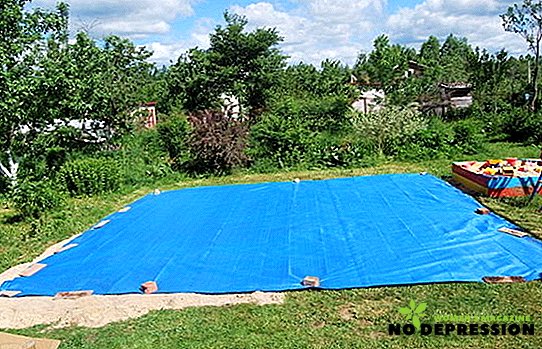
- Pour about 10 cm of water onto the bottom of the water, and water should be poured gradually, without forgetting to straighten the folds formed on the material. We also align the film on the walls. All work is desirable to carry out in the solar time of day, because under the influence of heat the film will be straightened better.
- After this, we install stiffeners outside, having mounted fixing strips along the upper edge of the structure.
- We insulate the walls with polystyrene.
- We fall asleep a ditch, and at this moment there must be water in the bowl.
- Optionally, you can optionally install a ladder, a pump, and filters to simplify the discharge of water.
- If there are gaps, they should be treated with silicone sealant.
After a day you can start using the pool!






